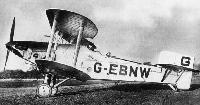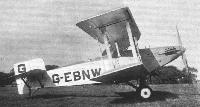
Описание
Страна : Великобритания
Год : 1927
Единственный экземпляр
Двухместный палубный бомбардировщик-торпедоносец
Avro серии 571 и серии 572 Buffalo
Avro серии 571 Buffalo разработан в соответствии со спецификацией (техническим заданием) 21/23 на двухместный палубный торпедоносец. Он являлся односекционным бипланом со складывающейся коробкой крыла, включавшей много конструктивных элементов, разработанных для ранее выпущенного Bison Mk II. Хвостовое оперение было тем же, но неубирающийся хвостовой костыль сделали иным. Фюзеляж также был спроектирован заново с учетом предназначения самолета. Задняя часть фюзеляжа содержала воздушные мешки для обеспечения плавучести в случае вынужденной посадки на воду. Также обеспечили возможность слива топлива, чтобы основной фюзеляжный топливный бак тоже удерживал машину на плаву.
Экипаж состоял из двух человек: пилота и стрелка-радиста-бомбардира, управлявшего турелью с двумя пулеметами Lewis, а также имевшего доступ в радиоотсек и к посту в нижней части фюзеляжа для бомбометания и ведения аэрофотосъемки.
По результатам оценочных испытаний, проведенных в 1927 году, "Avro" решила, что Buffalo имеет мало шансов выиграть контракт на серийное производство у Blackburn Ripon и Handley Page Н.P.31 Harrow. Самолет вернули на завод в Хэмбл для установки более мощного двигателя Napier Lion XIA и цельнометаллических прямоугольных крыльев с четырьмя элеронами Фрайза и регулируемыми предкрылками Хендли Пейджа. После этих доработок самолет сменил обозначение на 572 Buffalo Mk, но контракт он так и не выиграл. Однако прототип все же приобрело Министерство авиации, позднее его переделали в гидросамолет. Вариант бомбардировщика, серия 597, построен не был.
ТАКТИКО-ТЕХНИЧЕСКИЕ ХАРАКТЕРИСТИКИ
Avro серии 572 Buffalo Mk II
Тип: двухместный палубный бомбардировщик-торпедоносец
Силовая установка: трехрядный двигатель Napier Lion XIA мощностью 530 л. с. (395 кВт)
Характеристики: максимальная скорость 217 км/ч на оптимальной высоте; крейсерская скорость 169 км/ч на оптимальной высоте; начальная скороподъемность 235 м/ мин; практический потолок 3355 м; дальность полета 644 км
Масса: пустого самолета 1920 кг; максимальная взлетная 3370 кг
Размеры: размах крыла 14,02 м; длина 11,35 м; высота 4,27 м; площадь крыльев 63,54 мг
Вооружение: один неподвижный пулемет калибра 7,7 мм для стрельбы вперед и два наводимых пулемета калибра 7,7 мм для стрельбы назад плюс одна 457-мм торпеда внутри фюзеляжа
Описание:
- Avro серии 571 и серии 572 Buffalo
- Flight, July 1928
AVRO "BUFFALO”
Фотографии
-
Мировая Авиация 39
Регистрационный номер: G-EBNW [5], N239 [5] Buffalo Mk I, позднее модифицированный до стандарта Buffalo Mk II. В июле 1928 года самолет передали Министерству авиации с военным серийным номером N239.
-
Flight 1928-07 / Flight
Регистрационный номер: G-EBNW [5], N239 [5] -
Flight 1928-02 / Flight
Регистрационный номер: G-EBNW [5], N239 [5] AN AVRO TORPEDO BOMBER: Three views of the "Buffalo II" with Napier "Lion XA." Special features are the extremely "clean" nose and the slot-and-aileron control. The wings are swept back, and are designed to fold. The performance is believed to be very good.
-
Aeroplane Monthly 1982-10 / P.Capon - Capon's Corner
Регистрационный номер: N239 [5], G-EBNW [5] The Avro Type 572 Buffalo II N239 uas a torpedo bomber powered by a 530 h.p. Napier Lion XIA engine. It is seen at Hamble in August 1929.
-
Aeroplane Monthly 1982-10 / P.Capon - Capon's Corner
Регистрационный номер: N239 [5], G-EBNW [5] Inside the Avro Hamble works with the Avro Type 572 Buffalo N239 towering above the small fry.
- Фотографии




